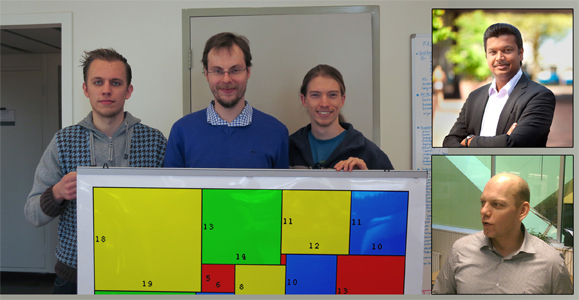MeesterDaan (talk | contribs) |
MeesterDaan (talk | contribs) |
||
| Line 2: | Line 2: | ||
==Introduction== | ==Introduction== | ||
| − | ASQAS-34 is a perfect rectangle packing problem solved by Braam, Moes, Suilen, Van den Berg and Bhulai in 2016 and earlier (unpublished) by Giovanni Resta. I'm still working on this page, but | + | ASQAS-34 is a perfect rectangle packing problem solved by Braam, Moes, Suilen, Van den Berg and Bhulai in 2016 and earlier (unpublished) by Giovanni Resta. I'm still working on this page, but [http://www.heuristieken.nl/resources/2016Braametal-AlmostSquares.pdf our '''paper''' is here]. I (Daan van den Berg) welcome all feedback you might have. Look me up in the UvA-directory, on LinkedIn or FaceBook. |
Revision as of 09:41, 18 November 2016
Introduction
ASQAS-34 is a perfect rectangle packing problem solved by Braam, Moes, Suilen, Van den Berg and Bhulai in 2016 and earlier (unpublished) by Giovanni Resta. I'm still working on this page, but our paper is here. I (Daan van den Berg) welcome all feedback you might have. Look me up in the UvA-directory, on LinkedIn or FaceBook.
Q&A
| 1. What is ASQAS-34 ?
ASQAS-34 is a Perfect Rectangle Packing Problem. In general, rectangle packing problems involve putting some set of rectangles inside a rectangular frame (often called a "container"). Those problems requires that you find the smallest container possible, hence it is an constrained optimization problem. In perfect rectangle packing problems, the frame has exactly the area of all the rectangles summed up. This means that if it fits, it fits perfectly, without free space or overlap in the rectangles, and a smaller container does not exist. Therefore, perfect rectangle packing problems such as ASQAS-34, are constraint satisfaction problems (or equivalently: a decision problem).
|
|
| 2. How did you solve it?
|
|
| 3. You call yourself an "VU-UvA consortium". Why is that?
Because we are a true VU-UvA collaboration. Mark, Florian and Emiel were VU-students when we started this work. They're all professionals now, and Emiel does some occasional work in proofreading Heuristics-reports at the UvA. That's where I work, in the "minor programming" (www.mprog.nl) where we teach the course of Heuristics. That course was originally built up at the VU back when I worked there so there's another link. Our colleagues teaching Heuristics at VU are Guszti Eiben and Bushra Malik. Sandjai, our senior author, also works at the VU as a Full Professor Business Analytics. He works on state-space reductions which is exactly the trick we deployed to solve ASQAS-34. |


